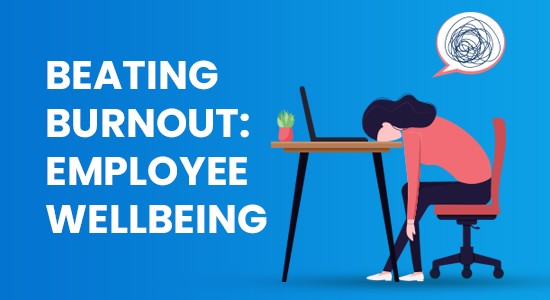BEATING BURNOUT: EMPLOYEE WELLBEING
Beating Burnout: Employee Wellbeing
Burnout has reached unprecedented heights in recent years. Burnout is a psychological illness that develops gradually in response to continuous interpersonal pressures at work. The three primary components of this response are extreme exhaustion, a sense of cynicism and alienation from the task, and a sense of inefficiency and lack of achievement.
It frequently predicts other mental health difficulties and is connected with anxiety and depression.
Everybody experiences burnout differently, but some frequent physical signs include exhaustion, headaches, alterations in eating or sleeping habits, and muscle tightness. Others might also go through emotional symptoms including worry, apathy, or job discontent.

What is the root of burnout at work?
Burnout at work is brought on by a chaotic or high-pressure environment, unclear or unreasonable job requirements, tedious or unchallenging work, a lack of appreciation or support, and a loss of autonomy or control.
Burnout is made worse when control over the workplace is removed. This is especially true now given recent global macroenvironmental shifts, such as the pandemic and its associated socioeconomic changes. Lack of control over an employee’s workload, working environment, and working hours can lead to stress and disengagement. This is accentuated in communities with neurodiverse members who would require regularity and control over their workplace. For instance, they might not react well to bright light or brightness, or they might find noise to be excessively distracting.
Although burnout occurs frequently in all kinds of employment, it is more common in high-stress settings like the healthcare and education sectors. Burnout in the clinical and healthcare sectors is mostly caused by an increase in workload, which is exacerbated by circumstances like the pandemic and personnel shortages.
- Evaluate as opposed to react
It’s simple to approach the issue of organizational burnout with a broad brush, but responding to that reality with a reflexive, “everything is wrong!” perspective is not only reductive but also makes it more difficult to introduce change inside your company. You’ll be far better able to suggest choices for systematic modifications to solve those difficulties if you take the time to look into and assess where the issues are.
- Set boundaries and working hours.
Setting clear boundaries for oneself is crucial for preventing burnout. Try to refrain from thinking about unfinished business or asking your coworkers any questions after the workday has ended. In the morning, these duties will still be present Setting boundaries with your boss and coworkers is crucial; let them know what hours you won’t be accessible and any personal commitments that are non-negotiable.

3. Disconnect –It is difficult to resist the urge to access your job whenever and wherever you want given the proliferation of technology that allows us to stay connected 24 hours a day. Outside of working hours, try turning off the notifications on your work emails. We should try Learning Triggers that Facilitate Detachment from Work.
4. Swap out work for a pleasant activity -You can mentally switch off from work and entirely focus by reading, running, or cooking. You might not feel entirely engaged and could start to think about work if you are doing something you don’t really enjoy only to do it with someone. Choose challenging activities to engage in. Even though it would seem like relaxing, watching TV, or other “passive” or “low-effort” activities are the greatest for healing, research shows that more vigorous activities can actually be even more beneficial. taking up a hobby that takes work or skill
In conclusion, burnout in work can be challenging to deal with . However, it not impossible to overcome . People can also prevent and reduce their burdens by taking care of themselves by following a healthy diet , balanced sleep and a good routine .


